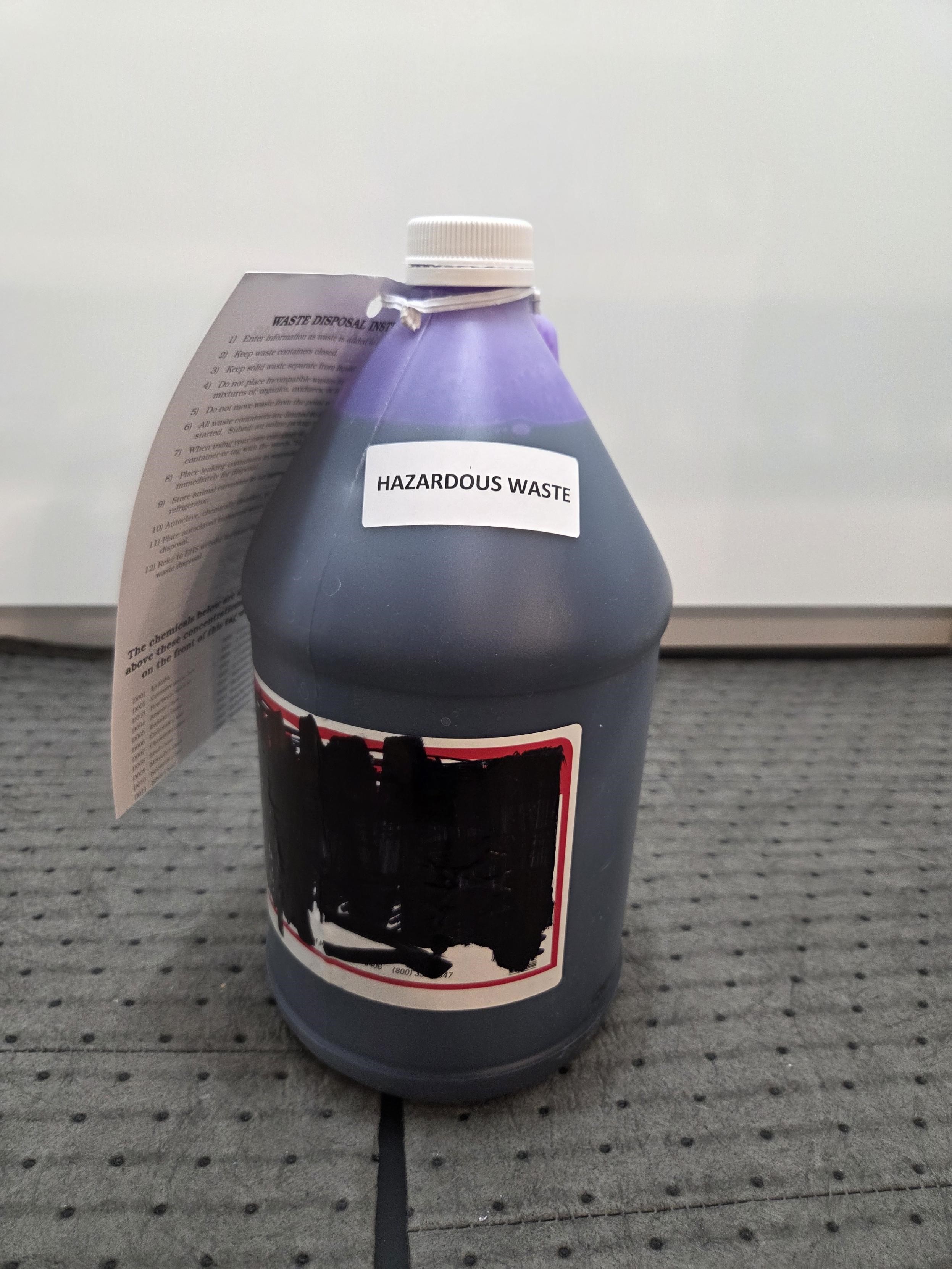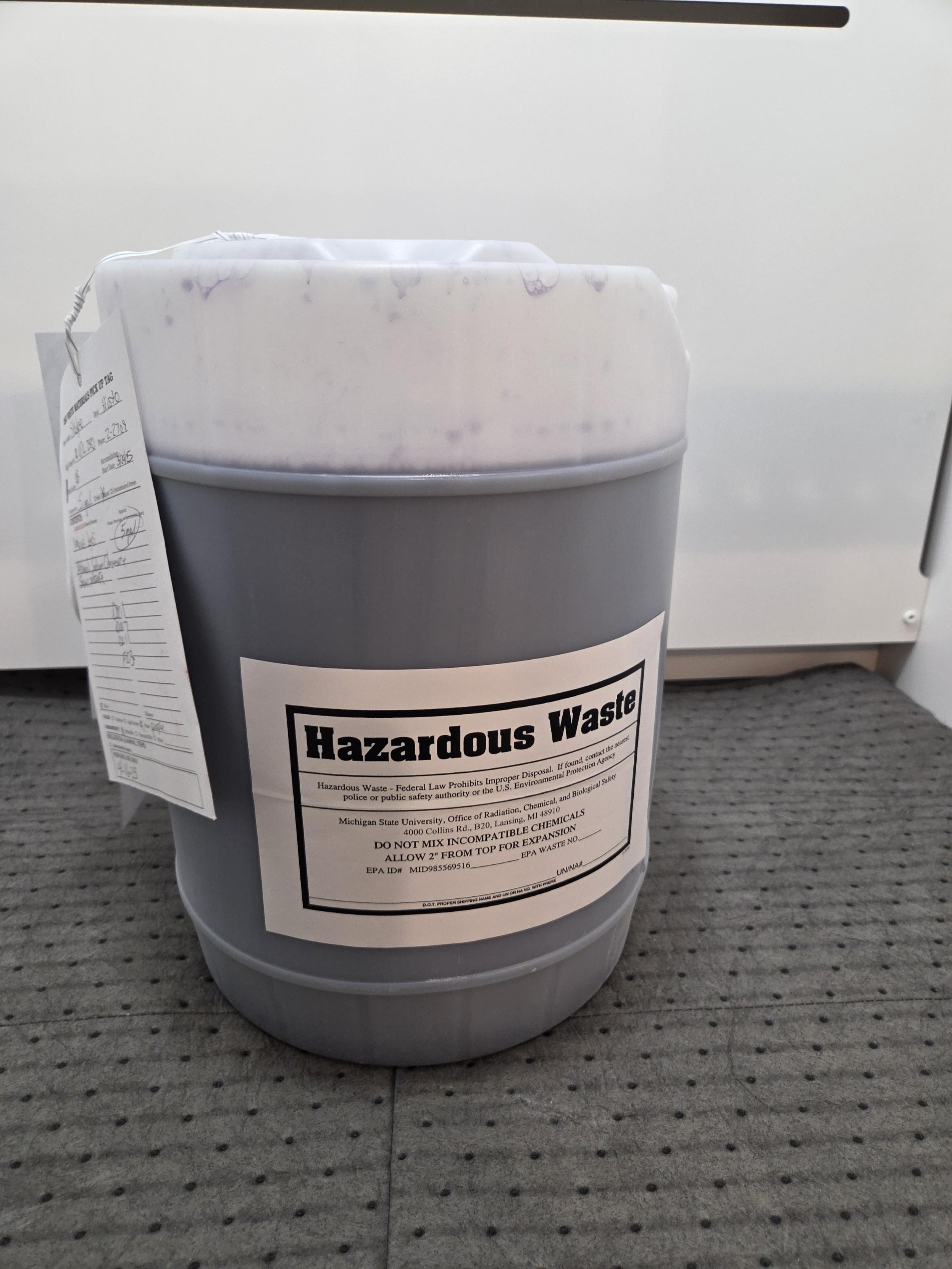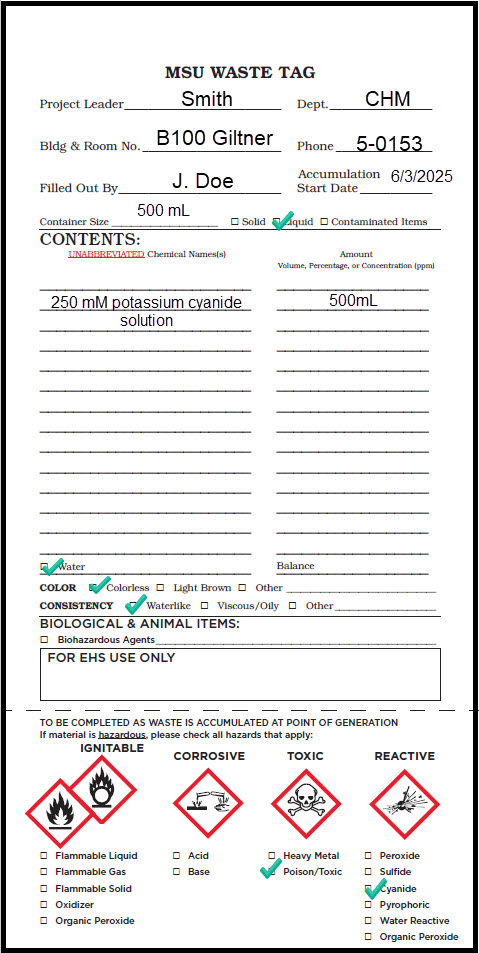Reactive Liquids/Solids
Definition
Reactive materials include solids, liquids, and gases that can have any of the following properties:
- Normally unstable and readily undergo violent change without detonating
- React violently and form explosive mixtures with water
- Generate toxic gases or fumes when mixed with water
- Self-detonate when struck or heated
- Contain cyanides or sulfides that release toxic gas at certain pH levels.
Reactive liquids and solids can become waste either when the original material becomes unwanted, or when they are produced in solutions with other chemicals. All reactive liquids and solids must be disposed of through the EHS Hazardous Waste program.
Reactive material waste cannot be disposed of down the drain. Refer to MSU’s Drain Disposal policy.
Common Types of Reactive Materials at MSU
- Water Reactive: Lithium Aluminum Hydride, tert-Butyl Lithium, Sodium, Potassium, Thionyl Chloride
Pyrophoric: Zinc and other metal powders, N-Butyl Lithium, Sodium Hydrosulfite, Organometallic substances - Other Materials: Cyanides, Sulfides
If using reactives, please see additional guidance and SOP information provided by EHS Chemical Safety.
Container Type
If disposing of unwanted reactive materials in the original manufacturer’s bottles with an intact label, the materials can be given directly to the EHS Hazardous Waste Program for disposal and should not be transferred into another container.
When reusing empty containers, they must be compatible with the type of chemical waste stored in them. Empty reagent bottles can be used for chemical waste collection after following the Empty Bottle guidance in the Waste Section of the EHS website.
Although EHS does not maintain a list of compatible materials, in general reactive liquids and solutions should be stored in plastic containers. However, do not store liquid waste in containers that previously held solids, as they will leak. Container compatibility information is also available on Safety Data Sheets. EHS provides 5-gallon high density polyethylene (HDPE) carboys for liquid hazardous waste storage, which are proven to be compatible with a variety of waste types.
Storage
Waste containers must be kept free of any liquids or residue on their exteriors. EHS Hazardous Waste Staff will reject any container with liquid or residue on the exterior until it has been cleaned. Leaking waste containers will not be accepted, and the contents must be transferred to a new container prior to disposal by the EHS Hazardous Waste group.
- All container lids MUST be closed tightly unless waste is being actively added to the container.
- Do not overfill containers.
- Secondary containment is not required but is recommended for waste storage.
- Do not accumulate more than 55-gallons total of hazardous waste in your location. This limit applies to the sum of full containers and partial containers being filled.
- Submit frequent requests for waste pick up through the EHS Hazardous Waste Request form to stay within the 90-Day storage limit and minimize the amount of waste containers in your space.
- Do not move hazardous waste from the location that it was generated.
MSU Waste Tag Required
Yes - A MSU Waste Tag is required for all waste not contained in a manufacturer’s bottle with an intact or legible label.
No - A MSU Waste Tag is not needed when submitting chemical reagents in the original manufacturer’s bottle with an intact label.
MSU Waste Tags must be directly affixed to the waste container either with string, a twist tie, chain and clipboard, rubber band, or tape. MSU Waste Tags are provided by EHS and can be requested through an EHS Hazardous Waste Request.
Labeling
A MSU Waste Tag should be filled out and completed when the first drop of waste is added to the container, or when the material becomes unwanted. The date the first drop or piece of waste is added to the container starts the 90-Day accumulation limit.
The contact information at the top of the MSU Waste Tag must be filled out to identify where the hazardous waste was generated, the container size and type, and who to contact with questions regarding the waste container.
All chemical constituents must be accounted for on the MSU Waste Tag. Chemical names must be printed legibly, in English, and with no abbreviations. The amount of chemical constituents can be captured by either using percentages up to 100%, or by units of volume. Either way, these need to match the amount of waste in the container when EHS arrives to pick up the material. Inaccuracies and discrepancies on the MSU Waste Tag can result in the waste being rejected by the EHS Hazardous Waste Staff for safety and compliance reasons. For aqueous solutions, the check box for “Water Balance” can be used to account for the remaining percentages or volume. Chemical constituents must be identified on the MSU Waste Tag as they are added to the container, as guessing the contents of a full container creates safety and compliance violations.
Review and check all applicable potential hazards at the bottom of the MSU Waste Tag each time when adding waste to the container. The color and consistency section can be completed when the container is full, or when approaching the 90-Day storage limit.
Submit Hazardous Waste Request
When the container is full or close to the 90-day accumulation limit, submit a Hazardous Waste Request via the EHS Safety Portal as follows:
- EHS Website: ehs.msu.edu
- Log in to the Safety Portal through a preferred web browser using your MSU Net ID and EBS Password
- Select Hazardous Waste Request
- Reactive Liquids and Solids are found under the Waste Container category
- Water Reactive liquid or solid
- Pyrophoric liquid or solid
- Reactive Liquids and Solids in the original, manufacturer’s bottle can be searched under the Reagents category




